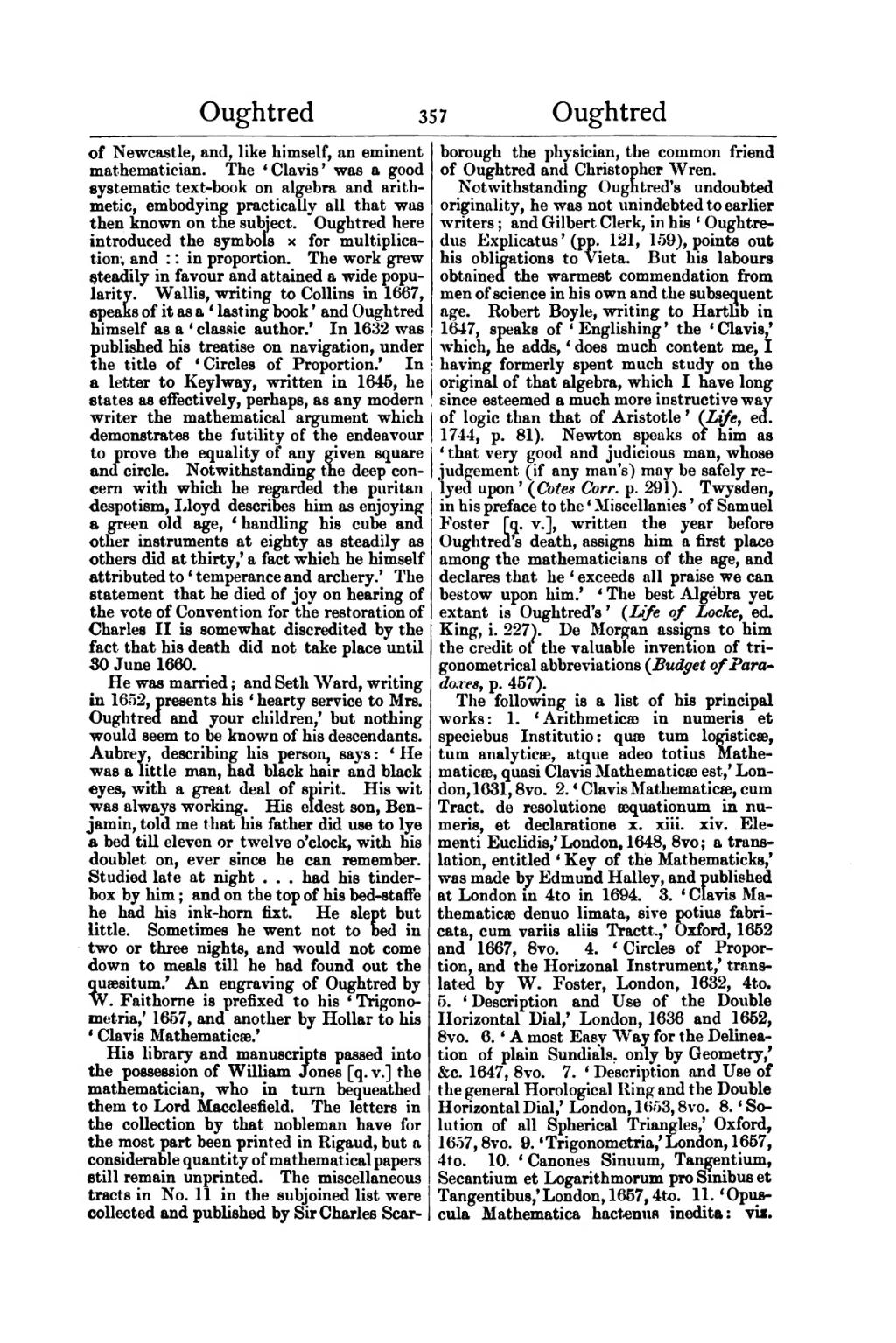of Newcastle, and, like himself, an eminent
mathematician. The 'Clavis' was a good systematic text-book on algebra and arithmetic, embodying practically all that was then known on the subject. Oughtred here introduced the symbols x for multiplication, and :: in proportion. The work grew steadily in favour and attained a wide popularity. Wallis, writing to Collins in 1667, speaks of it as a 'lasting book' and Oughtred himself as a 'classic author.' In 1632 was published his treatise on navigation, under the title of 'Circles of Proportion.' In a letter to Keylway, written in 1645, he states as effectively, perhaps, as any modern writer the mathematical argument which
demonstrates the futility of the endeavour to prove the equality of any given square and circle. Notwithstanding the deep concern with which he regarded the puritan
despotism, Lloyd describes him as enjoying a green old age, 'handling his cube and other instruments at eighty as steadily as others did at thirty,' a fact which he himself
attributed to 'temperance and archery.' The
statement that he died of joy on hearing of
the vote of Convention for the restoration of
Charles II is somewhat discredited by the
fact that his death did not take place until 30 June 1660.
He was married; and Seth Ward, writing in 1652, presents his 'hearty service to Mrs. Oughtred and your children,' but nothing would seem to be known of his descendants. Aubrey, describing his person, says: 'He was a little man, had black hair and black eyes, with a great deal of spirit. His wit was always working. His eldest son, Benjamin, told me that his father did use to lye a bed till eleven or twelve o'clock, with his doublet on, ever since he can remember. Studied late at night . . . had his tinderbox by him; and on the top of his bed-staffe he had his ink-horn fixt. He slept but little. Sometimes he went not to bed in two or three nights, and would not come down to meals till he had found out the quaesitum.' An engraving of Oughtred by W. Faithorne is prefixed to his 'Trigonometria,' 1657, and another by Hollar to his 'Clavis Mathematicæ.'
His library and manuscripts passed into the possession of William Jones [q. v.] the mathematician, who in turn bequeathed them to Lord Macclesfield. The letters in the collection by that nobleman have for the most part been printed in Rigaud, but a considerable quantity of mathematical papers still remain unprinted. The miscellaneous tracts in No. 11 in the subjoined list were collected and published by Sir Charles Scarborough the physician, the common friend of Oughtred and Christopher Wren.
Notwithstanding Oughtred's undoubted originality, he was not unindebted to earlier writers; and Gilbert Clerk, in his 'Oughtredus Explicatus' (pp. 121, 159), points out his obligations to Vieta. But his labours obtained the warmest commendation from men of science in his own and the subsequent age. Robert Boyle, writing to Harthb in 1647, speaks of 'Englishing' the 'Clavis,' which, he adds, 'does much content me, I having formerly spent much study on the original of that algebra, which I have long since esteemed a much more instructive way of logic than that of Aristotle' (Life, ed. 1744, p. 81). Newton speaks of him as 'that very good and judicious man, whose judgement (if any man's) may be safely relyed upon' (Cotes Corr. p. 291). Twysden, in his preface to the 'Miscellanies' of Samuel Foster [q. v.], written the year before Oughtred's death, assigns him a first place among the mathematicians of the age, and declares that he 'exceeds all praise we can bestow upon him.' 'The best Algebra yet extant is Oughtred's' (Life of Locke, ed. King, i. 227). De Morgan assigns to him the credit of the valuable invention of trigonometrical abbreviations (Budget of Paradoxes, p. 457).
The following is a list of his principal works: 1. 'Arithmeticæ in numeris et speciebus Institutio: quæ tum logisticæ, tum analyticæ, atque adeo totius Mathematicæ, quasi Clavis Mathematicæ est,' London, 1631, 8vo. 2. 'Clavis Mathematicæ, cum Tract. de resolutione æquationum in numeris, et declaratione x. xiii. xiv. Elementi Euclidis,' London, 1648, 8vo; a translation, entitled 'Key of the Mathematicks,' was made by Edmund Halley, and published at London in 4to in 1694. 3. 'Clavis Mathematicæ denuo limata, sive potius fabricata, cum variis aliis Tractt.,' Oxford, 1652 and 1667, 8vo. 4. 'Circles of Proportion, and the Horizonal Instrument,' translated by W. Foster, London, 1632, 4to. 5. 'Description and Use of the Double Horizontal Dial,' London, 1636 and 1652, 8vo. 6. 'A most Easy Way for the Delineation of plain Sundials, only by Geometry,' &c. 1647, 8vo. 7. 'Description and Use of the general Horological Ring and the Double Horizontal Dial,' London, 1653, 8vo. 8. 'Solution of all Spherical Triangles,' Oxford, 1657, 8vo. 9. 'Trigonometria,' London, 1657, 4to. 10. 'Canones Sinuum, Tangentium, Secantium et Logarithmorum pro Sinibus et Tangentibus,' London, 1657, 4to. 11. 'Opuscula Mathematica hactenus inedita: viz.
